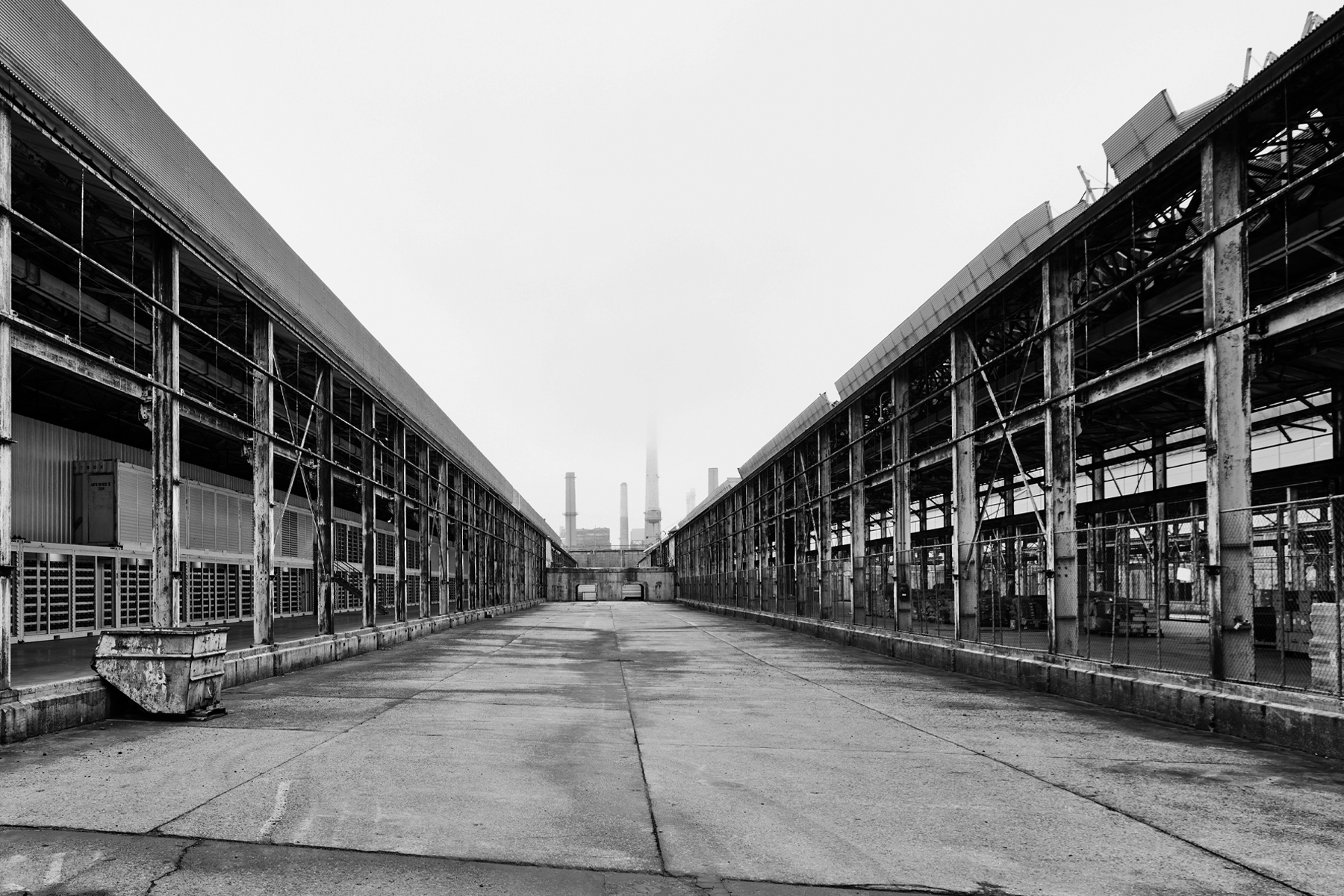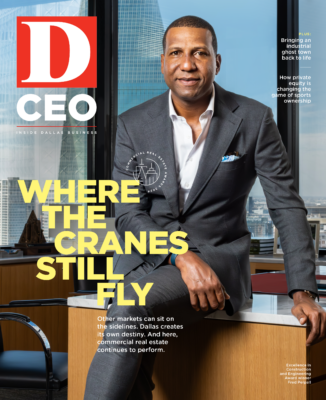On a temperate mid-January day, with a bird’s eye view from the helicopter of Dallas, then South Dallas, Randy Kendrick narrates the pieces of an infrastructure puzzle he’s connecting. Soon, we come upon the vast central plains of Texas and the mega-site of Sandow Lakes Ranch. Kendrick, CEO of Dallas-based Xebec Realty, relays how he sees his development syncing with shifting supply chains, logistics, and transportation infrastructure—the type of transformational convergence that’s only seen about once every 100 years.
We land at the office by Alcoa Lake, across from the industrial structures of “power island” and the defunct aluminum smelter. The success of the prized brownfield site was manifested by Tommy Hodges, a former Alcoa employee who’s now COO of Sandow Lakes. A six-year marketing odyssey by local broker Bernard “Bernie” Uechtritz further shaped the story. The two found their perfect suitor in developer Kendrick.
The Chernobyl-looking industrial land, surrounded by earth and lakes so pristine and poetic, is being remade into a modern-day township of technological innovation, creativity, and intelligence. “Sandow is in the sweet spot of Texas’ Golden Triangle—nothing like it exists,” Uechtritz emphasizes.
The development is 17 miles long and 50 square miles—more than twice the size of Manhattan. Just south a short distance from Rockdale and east of Taylor, where a Samsung chip foundry is being built, it’s anchored by the 914-acre Alcoa Lake, the former cooling waters of a mothballed Alcoa aluminum plant.
Built in the early 1950s, it was the largest aluminum foundry in the world for decades. It closed in 2008, having employed nearly 2,500 people. The new Alcoa foundry built in Iceland needs just 100 employees to run it, Kendrick says. “It’s a 50-year rule surrounding the lifespan of an industrial facility.” He refers to an infrastructure stock turnover rate not apparent to most. The Alcoa plant’s place in time has passed.
And now, reindustrialization is emerging in unique and Texas-style ways. With economic growth and shifts owing to the pandemic and geopolitics, there is a need to innovate and repurpose brownfield assets. North Texas visionaries on the vanguard are connecting energy, innovation, infrastructure development, and land use trends—with Sandow the posterchild.
Agents of Change
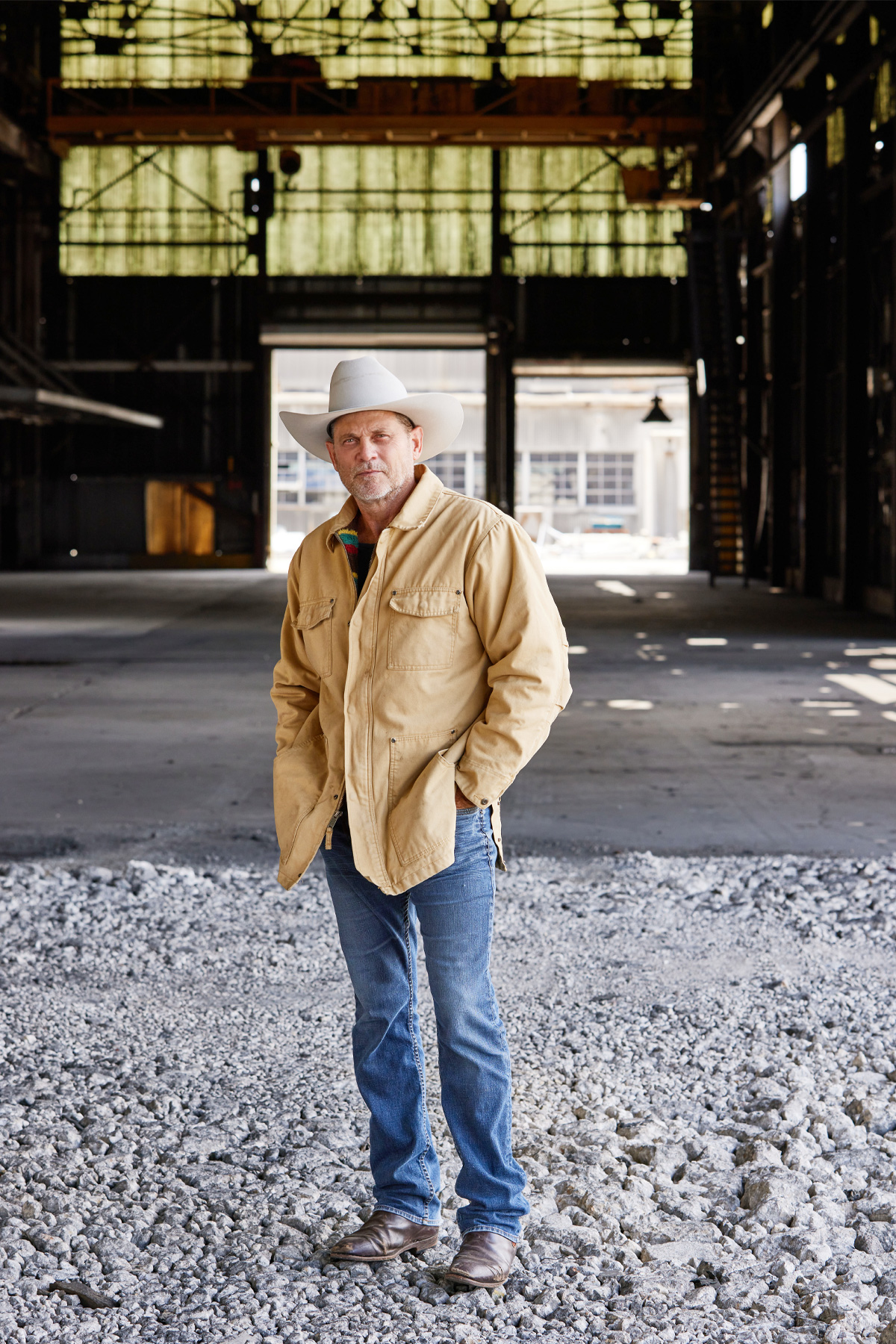
The transformation of the Alcoa property from preparation for sale to where it is today is complex. During the hand-off to Kendrick, who acquired the asset in November 2021, Hodges parted with these words: “Just don’t mess it up.”
Key in rebranding the mega-site as Sandow Lakes Ranch was Uechtritz of Icon Global. Responding to a request for proposal by Alcoa shortly after his renowned $725 million Waggoner Ranch sale in 2016, Uechtritz was selected to represent the industrial behemoth. “It was 33,000-plus acres of an incredible-looking sculptured landscape that was extraordinarily out of place in a Central Texas setting,” he recalls. “The terrain outside of Sandow is harsh and tough, gravelly and scrubby. But this site looked like it popped out of a Montana or Wyoming guidebook.”
In juxtaposition to rolling hills and a string of lakes were two hulking power plants. About a third of the site, 600 acres, was designated as industrial area, with two coal-fired power plants and the longest coal-carrying conveyor belt in the world.
Uechtritz was attracted to the deal by its novelty and sheer challenge. Once in his charge, he realized the daunting road ahead. “I had never done anything like this,” he says. “I wondered how I was going to do it. There’s a lot of water—and all this rusty metal. I honed in on the high value of the water [resources], given the demand and apparent pipelines from Austin and Georgetown to San Antonio.”
Along with its power island, the Alcoa development had a mega-switch and a Class 1 railroad switch. Alcoa even bought back a railroad spur it sold to add to the appeal. But future business neighbors and local communities became a big part of the draw in selling the site.
Uechtritz and Hodges paved a path with potential revenue streams to justify a price tag of $240 million. Meanwhile, the clock was ticking on the requirements for repurposing a brownfield site. “The picturesque landscape was largely unchanged through the sales process, but the industrial part changed dramatically,” Uechtritz says. Water deals were teed up to water utilities, which would ultimately sell to end users such as Samsung. Amazon and Tesla later moved to the area.
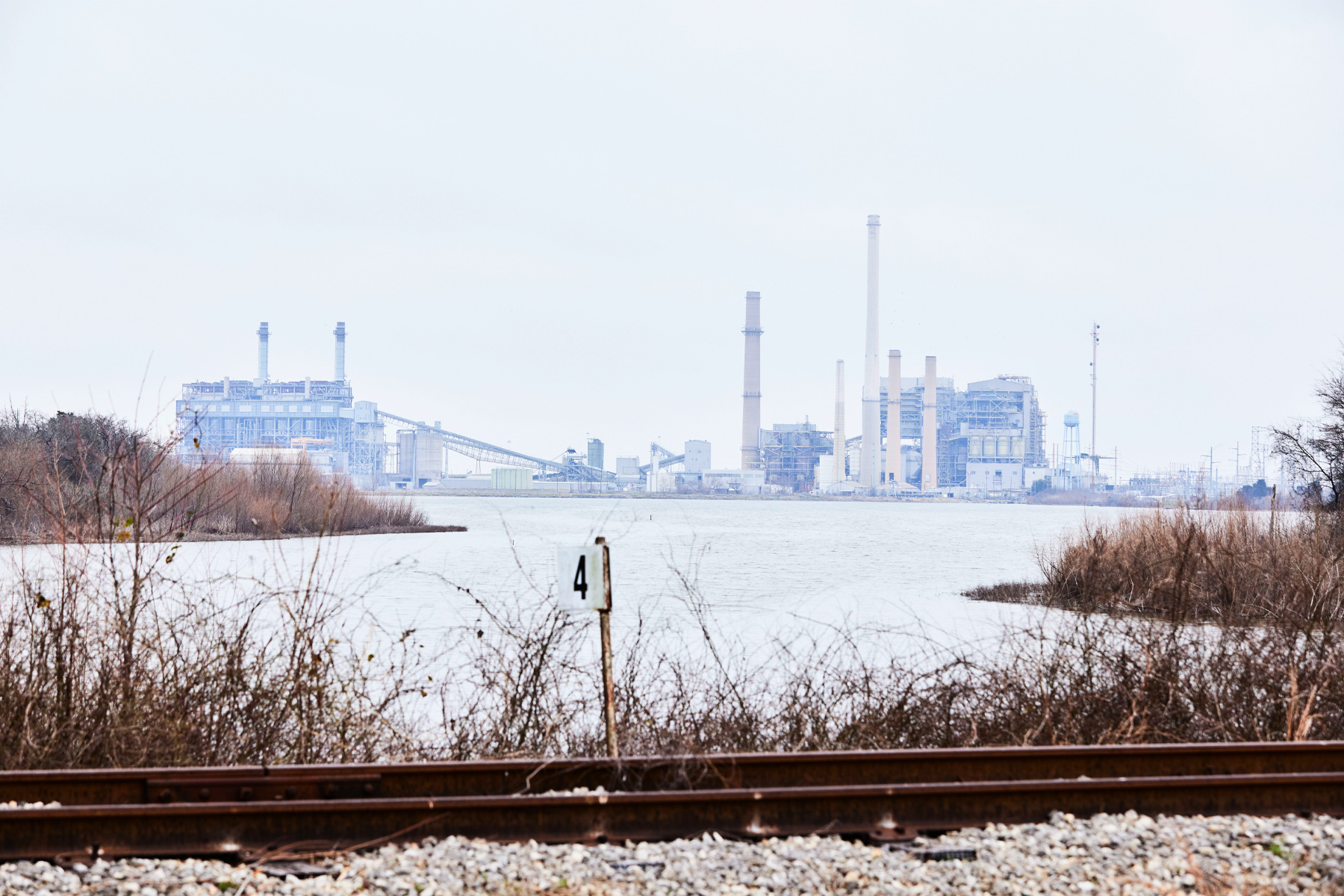
At one point, the site became an industrial ghost town with just a guard checkpoint and Hodges’ office. One coal-fired power plant shut down, and another was decommissioned, with Luminant’s bankruptcy in 2017. The old 25-mile conveyor belt sat idle.
New and different opportunities materialized. Some potential buyers wanted to store whiskey; others thought to build datacenters or the largest solar farm ever. A tech firm wanted a secret science lab; another hoped to convert Wyoming trash to energy, given the railway access. Ultimately, time and events favored the man who would emerge as Sandow’s new owner.
The Caretaker’s Plans
On board at Alcoa since 1983, Hodges oversaw the $350-million reclamation of the 17,500-acre Sandow mine that ran the smelter, creating the ultimate canvas for industrial and commercial use. Kendrick and Uechtritz credit him for envisioning the natural landscape that once was—and what it could become again.
Hodges managed almost every aspect of the land and venture, from making aluminum to power generation and mining coal. “I had a hand in acquiring and developing the property,” he says, “and then on the backend, its restoration.” The Sandow Mine, permitted as No. 001 in 1976, and 1,000 inspections later, was closed out by the Texas Railroad Commission in 2018.
In 1986, Hodges pioneered a technique for how materials were handled in the mining process based on the geology and terrain. At Sandow, having mined an average of 180 feet down, the surface-level hard clay gave way to sandy loam underneath, which Hodges repositioned as the high-grade topsoil for a rich and fertile future. Kendrick says it’s five times more fertile than the average ranchland in Central Texas. In 2018, the Department of Interior recognized the property as the best mine reclamation initiative in the U.S.
Under Hodges’ direction, some years past, Boy Scouts had planted trees—pecan, hickory, cedar, and oak groves. They cover nearly half of the entire property. Wildlife and nature are abundant. The 14 Hodges-made lakes of Sandow Lakes Ranch cover roughly 1,960 surface acres. Their bodies of water are “deeper than most lakes in Texas,” Kendrick says.
The Alcoa aluminum smelter was the major economic engine for Rockdale and surrounding counties. Today, the economic multiplier of Sandow will be significant. Its location downstream from Samsung and its suppliers suggests another hub in Texas’ expanding innovation and advanced manufacturing ecosystem.
Alcoa began looking for an end-game to posture the property for sale around 2010. “We wanted to create a path forward that could restore some, if not all, of that economic engine,” Hodges says. “This was going to be all-or-none. That’s how we approached it.” Once the sales team was formed, we realized the need to demonstrate the revenue potential outside of agriculture to potential buyers. “By the spring of 2020, we had that pretty well mapped out,” Hodges says, “enabling Alcoa to move on.”
The metamorphosis of Alcoa to Sandow happened organically. “I saw the pastures, water, and rolling hills and thought this was the sell,” says Uechtritz. “The ugly industrial bits and power island could be someone else’s problem because I didn’t know how to make that go away or deal with it.”

Hodges and Uechtritz mapped out a strategy like they were playing a game of chess. “Tommy moved the pieces around—how much resources they would use, water, fiber, and how to share them—including contenders like the Amazons and Musks,” Uechtritz says. “He was the supreme chess player, never taking his eye off the game. And now and then, he said ‘checkmate.’”
As the anchor in the middle, Hodges knew that selling the property required a certain mix of brokerage and synergy. Countless others tried to make end runs around him and Uechtritz. Hodges held the line.
The Visionary
Hodges and Uechtritz courted 40 potential suitors for the Alcoa property; then Randy Kendrick came along. It happened by accident, in an unrelated meeting, Uechtritz says. “On a regular 8 a.m. call the next day with Tommy, I said, ‘I think I met our guy.’”
Kendrick was impressed after seeing the property for the first time. “I couldn’t believe there was 50 square miles of land in the fastest-growing area in Texas,” he says, calling it a “true mixed-use super-structure.” Unfazed by the ugly site, he was attracted to its “location, place in time, water resources, and power.”
Kendrick, 59, was born in Las Vegas. His father worked in construction—specifically in rebar. His family then moved to Los Angeles. As a University of Southern California graduate, he did his first real estate development deal at age 22. He aligned with brokers who knew where the action was. Based in Dallas since 2018, after relocating from California, Xebec has a 30-plus year track record and 43 projects under development.
The advent of the shipping container played an outsized role in his success. Global ports had to coordinate and come to an agreement to allow for the globalization of the 1986-to-early 2000s phase. The day we visited Sandow, as we flew across North Texas, Kendrick explained and showed how railroads are still a foundation of American commerce. Online shopping rocket-boosted this modifying industrial era. The shipping container allowed for intermodal transportation—from ship to train to truck, that is.
Now, with the Walmarts and Amazons, online shopping and fulfillment, another level of many ‘forces converging’ is apparent to Kendrick. “Developers make something out of nothing,” he says. But that’s not all.
The pandemic reshuffled the global economic deck in new ways. It was kerosene poured onto the fire for a renaissance in American manufacturing. Nowhere is that more apparent than the reindustrialization that’s taking hold in Texas.
A Lot of Cool
As Uechtritz and Hodges prepared Sandow for its next owner, the pandemic revealed competitive gaps and vulnerabilities. The Biden Administration passed the Bipartisan Infrastructure Deal in November 2021, followed by the CHIPS and Science Act, a $52 billion investment signed in August 2022, after the Sandow deal closed. This signaled the U.S. recognized its need to return manufacturing and supply chains to America.

In early 2022, Samsung broke ground in Taylor on what has become a nearly $30 billion semiconductor foundry, or fabs, to power next-generation tech in areas like 5G, AI, and high-performance computing. Sandow is supplying water resources to Samsung, a significant benefactor of Sandow’s infrastructure. We flew over the foundry’s construction, with Kendrick commenting on the 24/7 activity to move into chip production.
The first-announced phase of Sandow’s master plan, the Advanced Manufacturing and Logistix Campus, or “AMLC,” will feature up to 50 million square feet of industrial space. Prospects include Amazon and national third-party logistics firms but also high- and low-tech manufacturing. Kendrick mentions that 3D printing and additive manufacturing are game-changers for reshoring supply chains to America. He expects the densest part of Sandow’s gross domestic product to be the AMLC, reflecting “modern-scale economic activity.”
The potential of the water and energy resources was a significant point of attraction for Kendrick in the Sandow deal. He well understands how critical water supplies have become, given his Los Angeles experience. The rechargeable Simsboro aquifer lies underneath the property and will have a conscious caretaker.
Power island, with its many industrial leftovers, offers Kendrick “adaptive reuse opportunities,” he says. On the day of the visit, power was top of mind with Winter Storm Uri still fresh in the collective consciousness. Kendrick notes that Texas is short 16 gigawatts in the Triangle, based on a Texas A&M study. Sandow is part of the solution. Its renowned Sandow switch is 1.5 gigawatts—strategic infrastructure for connecting the northern and southern parts of Texas to the grid. Two new switches are planned, as is a state-of-the-art natural gas power plant—a 1,200-megawatt, ultra-efficient facility expected to break ground in 2025 and be operational by 2028—and solar.
Energy demand is growing. Datacenters, quantum computing, and AI require a lot of power. But availability and reliability could become a growth-limiting factor. Kendrick is planning electrical infrastructure with carbon neutrality in mind.
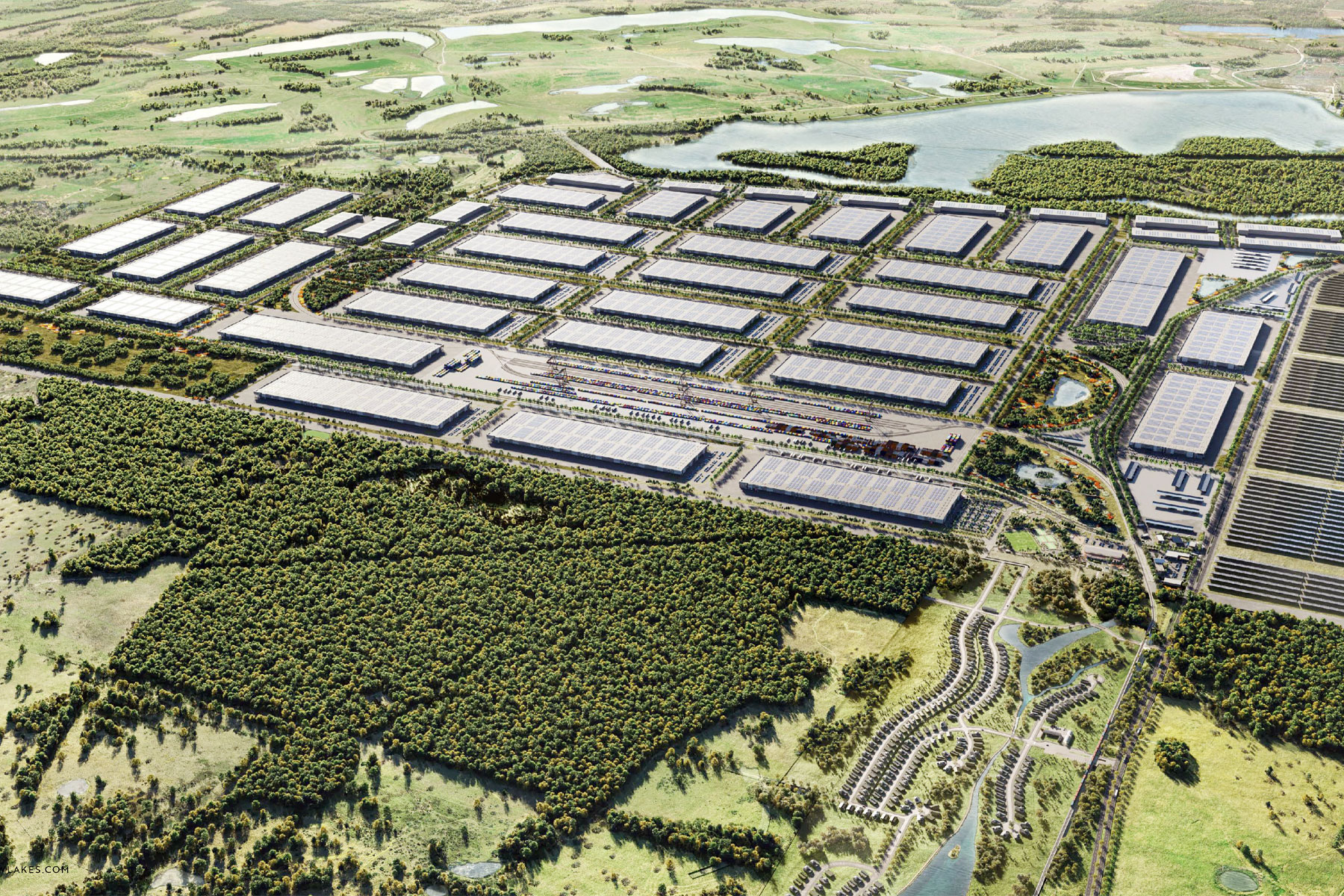
Uechtritz says a certain entrepreneurial vision was required to realize the possibilities. “A place like Sandow requires a guy to walk in and say, ‘I got this,’” he says. “One that says, ‘F—k, this could be really cool.’ He isn’t bothered by the obstacles; he knows in himself he’ll overcome them and find those with the right answers. That’s who Randy is.”
The reindustrialization theme in land use has examples scattered across the U.S., with rust and worn-out infrastructure that can be revitalized—true circular economy dreams. Ultimately, Sandow Lakes will house tenants from high- and low-tech manufacturers—names old and new—to “creative types and tech-forward innovators.”
As we wrapped up our conversation, I asked Kendrick about Sandow’s aesthetic: “Eclectic” was his one-word reply. To him, Texas is like California in the 1970s, with a lot of cool yet to be created.


